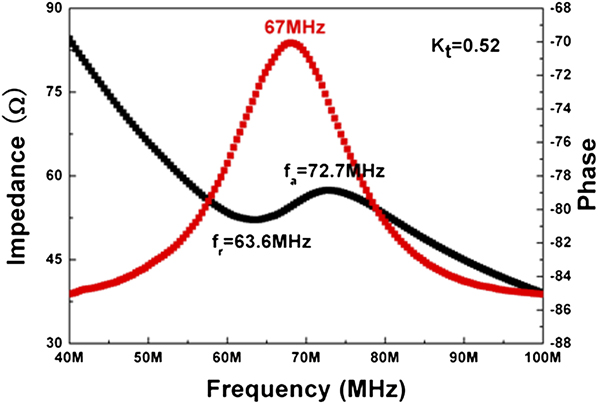Crossref Citations
This article has been cited by the following publications. This list is generated based on data provided by
Crossref.
ZHOU, QIFA
LAM, KWOK HO
ZHU, BENPENG
ZHANG, XIABING
SHUNG, K. KIRK
YANG, TONGQING
and
TAKEUCHI, S.
2012.
PZT FILM GENERATOR DRIVEN BY ULTRASONIC WAVE.
Journal of Advanced Dielectrics,
Vol. 02,
Issue. 03,
p.
1220001.
Zhu, Benpeng
Chan, Ngai Yui
Dai, Jiyan
Shung, K. Kirk
Takeuchi, Shinichi
and
Zhou, Qifa
2013.
New fabrication of high-frequency (100-MHz) ultrasound PZT film kerfless linear array [Correspondence].
IEEE Transactions on Ultrasonics, Ferroelectrics, and Frequency Control,
Vol. 60,
Issue. 4,
p.
854.
Zhu, Benpeng
Xu, Jiong
Li, Ying
Wang, Tian
Xiong, Ke
Lee, Changyang
Yang, Xiaofei
Shiiba, Michihisa
Takeuchi, Shinichi
Zhou, Qifa
and
Shung, K. Kirk
2016.
Micro-particle manipulation by single beam acoustic tweezers based on hydrothermal PZT thick film.
AIP Advances,
Vol. 6,
Issue. 3,
Sano, Ko-Hei
Karasawa, Rei
and
Yanagitani, Takahiko
2017.
Thick ScAlN film for high efficient ultrasonic transducer in low frequency of 81 MHz.
p.
862.
Sano, Ko-hei
Karasawa, Rei
and
Yanagitani, Takahiko
2017.
High electromechanical coefficient k<inf>t</inf>2=19% thick ScAlN piezoelectric films for ultrasonic transducer in low frequency of 80 MHz.
p.
1.
Rath, Martando
Varadarajan, E.
Premkumar, S.
Shinde, Sd
Natarajan, V.
and
Ramachandra Rao, M. S.
2019.
Studies on ferroelectric and nanomechanical response of single-layered PZT thick film for energy harvester applications.
Ferroelectrics,
Vol. 551,
Issue. 1,
p.
17.
Wang, Zhiyang
Yang, Fei
Ma, Haigang
Cheng, Zhongwen
and
Yang, Sihua
2020.
Photoacoustic and ultrasound (PAUS) dermoscope with high sensitivity and penetration depth by using a bimorph transducer.
Journal of Biophotonics,
Vol. 13,
Issue. 9,
Wang, Jialin
Park, Mingyo
Mertin, Stefan
Pensala, Tuomas
Ayazi, Farrokh
and
Ansari, Azadeh
2020.
A Film Bulk Acoustic Resonator Based on Ferroelectric Aluminum Scandium Nitride Films.
Journal of Microelectromechanical Systems,
Vol. 29,
Issue. 5,
p.
741.
Zhao, Kuipeng
Yuan, Yuheng
Wang, Dazhi
Zong, Haoran
Lu, Liangkun
Xu, Pengfei
Wang, Lunxiang
Jiang, Chaoyang
Jiang, Zhongqi
Li, Yan
and
Wang, Zhu
2021.
Fabrication and characterisation of piezoelectric thick-film microcantilever deposited on stainless steel using electrohydrodynamic jet deposition.
Ceramics International,
Vol. 47,
Issue. 20,
p.
28736.
Wang, Jialin
Zheng, Yue
and
Ansari, Azadeh
2021.
Ferroelectric Aluminum Scandium Nitride Thin Film Bulk Acoustic Resonators with Polarization‐Dependent Operating States.
physica status solidi (RRL) – Rapid Research Letters,
Vol. 15,
Issue. 5,
Wong, C.M.
Chan, S.F.
Liu, R.
Zhang, J.
Wu, W.C.
Liang, Z.
Yau, H.M.
Wang, D.Y.
Li, S.
Lam, K.H.
Qiu, W.B.
Luo, H.S.
and
Dai, J.Y.
2022.
20-MHz phased array ultrasound transducer for in vivo ultrasound imaging of small animals.
Ultrasonics,
Vol. 126,
Issue. ,
p.
106821.
Li, Guo
Sun, Qiandong
Fu, Yapeng
Hou, Shilin
Zhang, Jiaming
Xu, K.L.
and
Dai, J.Y.
2024.
A single crystal row–column-array for 3D ultrasound imaging.
Ultrasonics,
Vol. 139,
Issue. ,
p.
107289.
Dunce, Marija
Plyushch, Artyom
Birks, Eriks
Svirskas, Šarūnas
Banys, Jūras
Jankauskas, Paulius
Bikse, Liga
Atvars, Arturs
Freimanis, Otto
Leimane, Madara
and
Bundulis, Arturs
2024.
Free‐standing 0.9Na0.5Bi0.5TiO3‐0.1Sr0.7Bi0.2TiO3 thick films produced by water‐based tape‐casting method.
Journal of the American Ceramic Society,
Vol. 107,
Issue. 10,
p.
6532.



